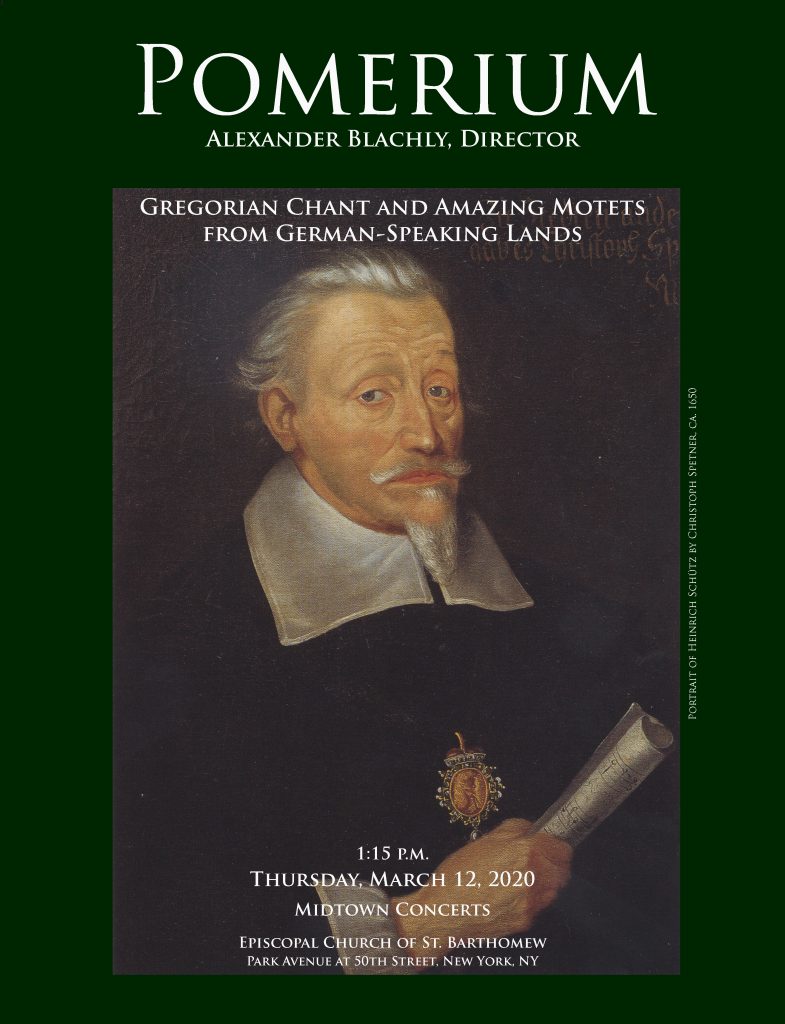March 12, 2020
FREE AND OPEN TO THE PUBLIC
PROGRAM
CHANT FOR ADVENT
| Hymn: Veni redemptor gentium | Luca Lossius, Psalmodia, hoc est cantica sacra (1561) |
CHANT FOR DECEMBER 17
| Antiphon: O Sapientia | Klosterneuburg, Bibl. 1013 (12th cent.) |
CHANT FOR CHRISTMAS
| Hymn: A solis ortus cardine | St. Gall MS 440 (1467) |
CHROMATIC MOTET I
| Motet: Mirabile mysterium | Jacobus Gallus (1550-1591) |
CHANT FOR LENT I
| Gradual: Angelis suis | Graz MS 807 (12th cent.) |
CHANT FOR EASTER
| Gradual: Hec dies | St. Gall MS 1758 (1473) |
CHROMATIC MOTET II
| Motet: Ad Dominum cum tribularer | Hans Leo Hassler (1564-1612) |
CHANT FOR ASCENSION
| Sequence: Summi triumphum (ca. 884) | Notker Balbulus (in Franz Eler, Cantica sacra, 1588) |
CHANT FOR PENTECOST
| Communion: Factus est repente | St. Gall MS 1758 |
CHROMATIC MOTET III
| Motet: Dulcissime et benignissime Christe (1625) | Heinrich Schütz (1585-1672) |
Pomerium
Kristina Boerger, Amber Evans, Dominique Surh – sopranos
Emerson Sieverts, Michael Steinberger, Christopher Preston Thompson – tenors
Peter Stewart, Peter Walker – basses

This concert is made possible, in part, with public funds from the New York State Council on the Arts, with the support of Governor Andrew Cuomo and the New York State Legislature.
Commentary on the Programby Alexander Blachly Gregorian Chant in German-speaking lands resisted its late-medieval development in European countries further to the west (Italy, France, Spain, England). The distinguishing features of German chant are its non-adoption of the square notation we normally associate with Gregorian chant, and a preference for C in phrases that peak on B or B-flat in the Roman tradition and for F in phrases that peak on E in the Roman tradition. Whether the preference for C and F is a late development, as some chant scholars have argued, or was already deeply embedded in the memories of German singers from before the time when the melodies were first written down in the eighth, ninth, and tenth centuries, continues to be debated. The ancient existence of the German variants seems confirmed, however, by their appearance in the earliest chant manuscripts in which pitches are clearly indicated (eleventh and twelfth centuries). Peter Wagner, stationed in Fribourg for his entire career and the first scholar to study the phenomenon of a “German chant dialect,” thought that the preference for C and F in the peaks derived from a “more resolute” piety than that of the chanters to the west, whose melodies he characterized as “softer” and “feminine.” In contrast to the conservatism of German chant, polyphony in German lands, beginning in the late Renaissance, showed an interest in the latest trends in adventurous compositional ideas. As a counterpart to the diatonic character of chant melodies, which do not include “black-key” notes beyond B-flat, the three “amazing” motets heard today essentially revel in the expressive and avant-garde sound of strange and unexpected harmonies produced by many, sometimes nearly all, of the notes of the chromatic scale. In Jacobus Gallus’s Mirabile mysterium the strange harmonies are intended to reflect the strangeness of Christ’s incarnation at Christmas, when the natural order was altered by God’s having assumed the nature of man, while not losing his divine nature—and with these two natures neither “mixing” nor “dividing,” as the music dramatically illustrates. Hans Leo Hassler’s Ad Dominum cum tribularer, a setting of Psalm 119:1-2, first expresses the psalmist’s cry to God in ascending chromatic scales evoking tribulation, then in rolling waves of notes represents his relief on being heard by God, and finally with a series of descending chromatic scales paints in sound the “wicked lips” and “deceitful tongue” from which he pleas to be spared. Heinrich Schütz, who learned the latest trends in seventeenth-century polyphony from Giovanni Gabrieli and later Claudio Monteverdi, used searing dissonances in Dulcissime et benignissime Christe to different effect: to intensify the wholly positive meanings of “most sweet” and “kindest.” |
